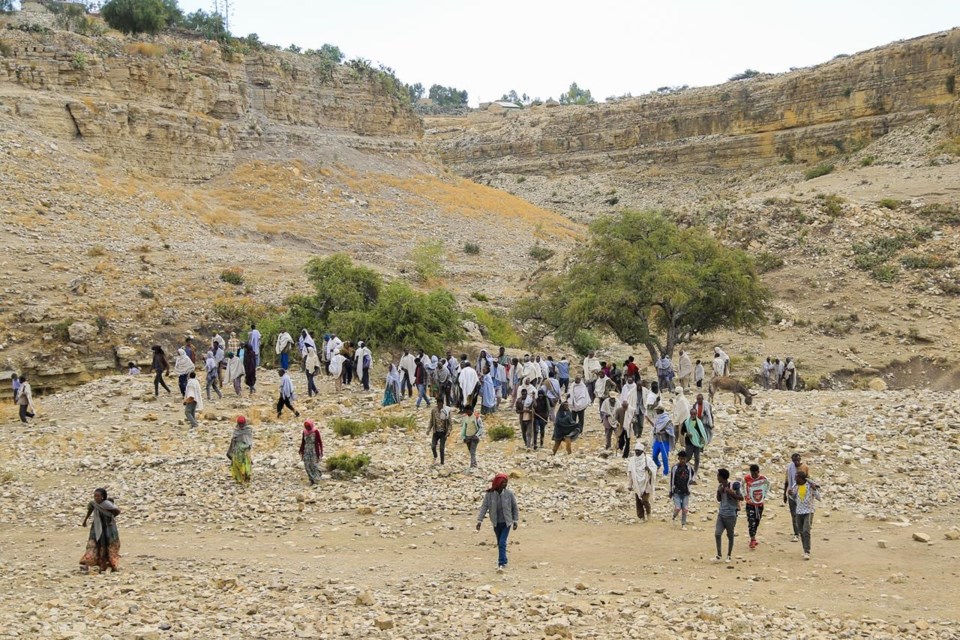NEBAR HADNET, Ethiopia (AP) ŌĆö The cruel realities of war and drought seem to have merged for Tinseu Hiluf, a widow living in the arid depths of Ethiopia's Tigray region who is raising four children left behind by her sister's recent death in childbirth.
A two-year war between federal troops and regional forces killed one of her own sons, the rest of whom are already adults. And now, a lack of food stemming from the region's drought has left the youngest of the children she is raising malnourished.
She tries to forage seeds among the scarce greenery of the desert's yellow, rocky landscape. But she recently resorted to traveling to the nearby Finarwa health center in southeastern Tigray to try to keep the 1-year-old baby alive.
ŌĆ£When hungry, we eat anything from the desert,ŌĆØ she said. ŌĆ£Otherwise, nothing.ŌĆØ
She joined several other mothers seeking help at the center in the remote administrative area of Nebar Hadnet. A mother of five complained that she had no breastmilk for her eight-month-old baby. Another with 1-year-old twins said she needed sachets of baby food to keep ŌĆ£my babies alive.ŌĆØ
Tigray is now peaceful but warŌĆÖs effects linger, compounded by drought and a level of aid mismanagement that caused the U.N. and the U.S. to temporarily suspend deliveries last year.
Once-lush fields lie barren. Mothers, faces etched with worry, watch helplessly as their children weaken from malnutrition. in Tigray and the neighboring Amhara region in the six months leading to January, the national ombudsman revealed in January, a rare admission of hunger-related deaths by a federal government.
Most of those deaths were recorded in Tigray, home to 5.5 million people.
Until the signing of in November 2022, the region was the scene of a deadly war between federal troops and forces loyal to the regionŌĆÖs now-ousted ruling party. But months after the end of the conflict, because of a massive scheme by Ethiopian officials to steal humanitarian grain.
An inadequate growing season followed.
Persistent insecurity meant only 49% of TigrayŌĆÖs farmland was planted during the main planting season last year, according to an assessment by U.N. agencies, NGOs and the regional authorities, and seen by the AP. Crop production in these areas was only 37% of the expected total because of drought. In some areas the proportion was as low as 2%, that assessment said.
The poor harvest prompted TigrayŌĆÖs authorities to warn of an ŌĆ£unfolding famineŌĆØ that could match the famine of 1984-5, which killed hundreds of thousands of people across northern Ethiopia, unless the aid response was scaled up. Food deliveries to Tigray in the second half of last year, but only a small fraction of needy people in Tigray are receiving food aid, humanitarian workers say.
Finarwa, a farming community of about 13,000 people, is among the worst-hit places.
The town's health center still has war-damaged equipment and some of its rooms appear abandoned. Tadesse Mehari, the officer in charge of the clinic, said the lack of food at homes in the community has forced children to flee and beg in nearby towns.
ŌĆ£Nothing here to eat. So, for the sake of getting food and to save their lives, they are displaced anywhere, far from here,ŌĆØ he said. ŌĆ£So, in this area, a lot of people are suffering. They are starved. They are dying due to the absence of food.ŌĆØ
Some local leaders, feeling helpless, have been turning their own people away
Hayale Gebrekedian, a Nebar Hadnet district leader for five years, listened to the pleas of villagers who streamed into his office one recent afternoon. A widow named Serawit Wolde with 10 children was in tears as she recounted that five of them were falling ill from hunger.
ŌĆ£Please, any help,ŌĆØ she told Hayale.
Hayale told the woman he had nothing to give. ŌĆ£There simply isnŌĆÖt any (food),ŌĆØ he said.
Hayale later told the AP, ŌĆ£This place used to be a source of hope, even for those displaced by the war. We had enough for everyone, but now we canŌĆÖt even feed ourselves.ŌĆØ
ŌĆ£The war took everything," he said. ThereŌĆÖs nothing left.ŌĆØ
Havale said access to water was an additional challenge. Of the 25 wells that once sustained the community and its animals, only five remained functional. People now trek for over an hour and a half to access water, he said.
The region's drought has meant that some areas that usually get about 60 days of rain during the rainy season have seen only a few.
Some farmers aren't giving up.
Haile Gebre Kirstos, 70, continued to plough his parched land and plant sorghum in a village in Messebo, although rain fell ŌĆ£only two days during the last rainy season,ŌĆØ he said.
Once lush and teeming with livestock, the land is now a barren expanse, yet he remained hopeful even after the failure of the previous harvest.
Although the ploughing usually doesnŌĆÖt begin until the rainy season in May or June, this year he started the work early, driven by extreme need. He spoke of farmers who have sold their oxen and farming tools to feed their families.
For him, the memory of the 1980s famine is haunting. ŌĆ£It affected the entire region then,ŌĆØ he said. ŌĆ£Now, in some districts, itŌĆÖs either as bad as the 1980s, or even worse.ŌĆØ
___
AP Africa news:
The Associated Press receives financial support for global health and development coverage in Africa from the Bill & Melinda Gates Foundation Trust. The AP is solely responsible for all content. Find APŌĆÖs for working with philanthropies, a list of supporters and funded coverage areas at .ŌĆØ
Amir Aman Kiyaro, The Associated Press



